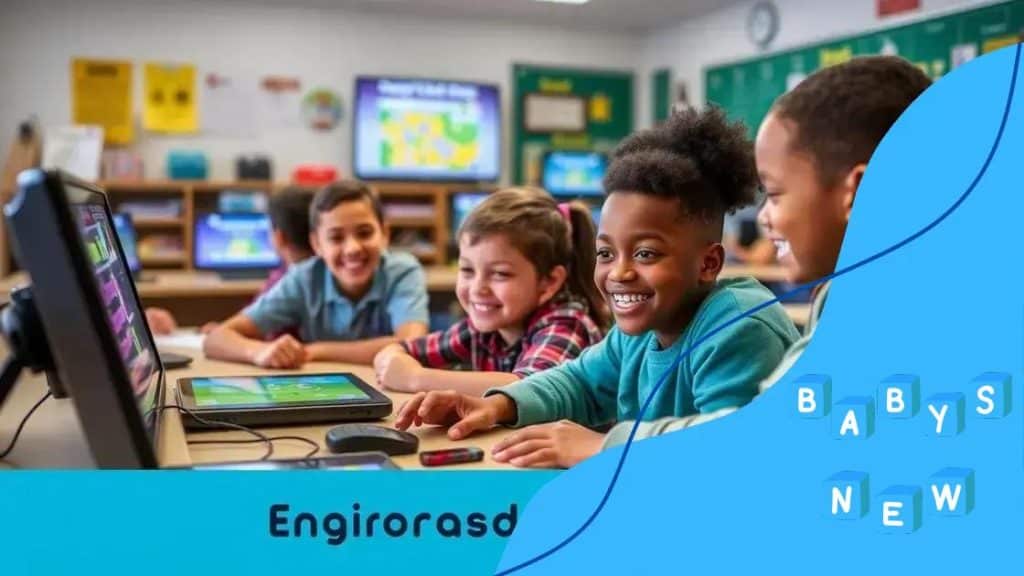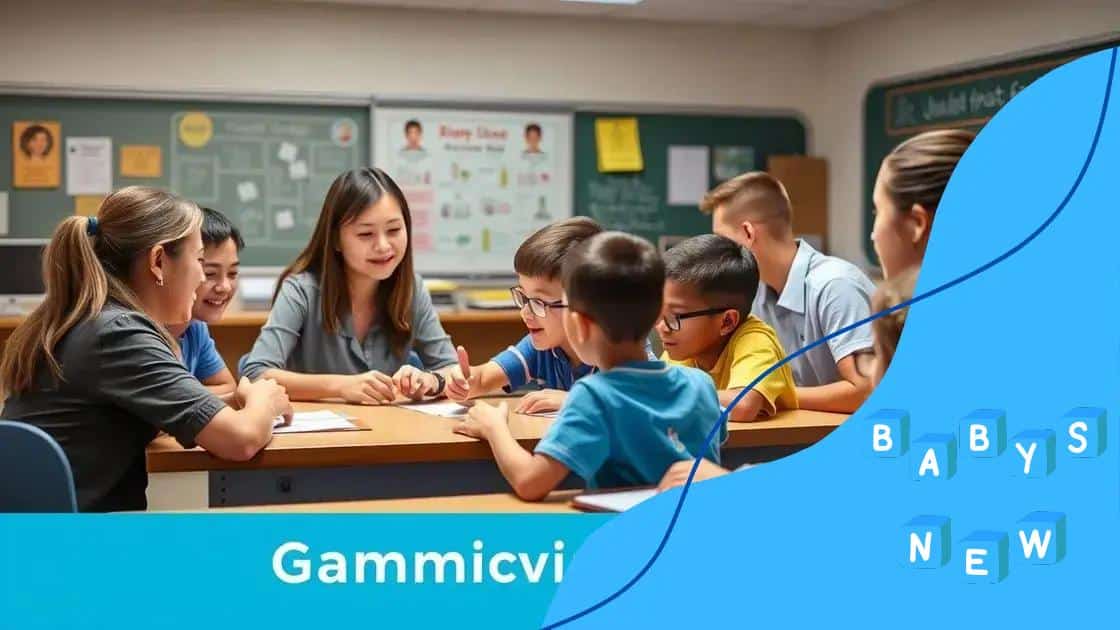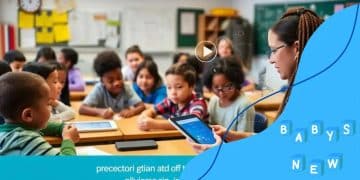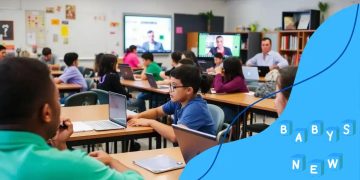Gamification in education: transforming learning experiences

Advertisement
Gamification in education utilizes game elements to enhance student engagement, motivation, and learning outcomes, transforming traditional educational experiences into interactive and enjoyable environments.
Gamification in education is changing the way we approach learning. You might wonder how game elements can make lessons more engaging and effective. This article dives into the exciting world of gamified learning and its impact on students.
Understanding gamification in education
Understanding gamification in education explains the use of game-like elements in learning environments. By incorporating these elements, educators can increase student motivation and engagement. The idea is simple: when learning feels like a game, students are more likely to participate and enjoy the process.
Gamification uses features from video games, such as points, badges, and leaderboards, to create a more dynamic learning experience. This method isn’t just about making learning fun; it’s about fostering skills such as collaboration, problem-solving, and critical thinking.
Advertisement
Key elements of gamification
To effectively use gamification in education, several key elements should be considered:
- Goals: Setting clear objectives gives students direction.
- Feedback: Immediate feedback helps students understand their progress.
- Rewards: Recognizing achievements boosts motivation.
- Challenge: Engaging challenges promote skill development.
When we apply these elements, we can see how gamification makes an impact. Students become more engaged and eager to learn. They enjoy the challenge of achieving goals and often work harder when they know they can earn rewards.
The science behind gamification
Research supports the effectiveness of gamification in education. Studies have shown that students who learn through gamified methods demonstrate improved retention of information. Gamification also encourages a sense of community among students.
Advertisement
For instance, when students collaborate on challenges, they develop teamwork skills. These social interactions contribute greatly to a positive classroom atmosphere. In gamified learning environments, students become more than just passive recipients of information.
They actively participate, making the classroom experience richer and more fulfilling. The excitement from game mechanics encourages students to pursue knowledge actively, which can lead to lifelong learning.
Incorporating gamification into educational tools can transform traditional methods, making lessons more relevant and enjoyable for students. Gamification isn’t just a passing trend—it’s changing the landscape of education.
Benefits of gamification for learners
Benefits of gamification for learners are far-reaching and impactful. This educational strategy not only makes learning enjoyable but also contributes to better retention of knowledge. When students engage with gamified activities, they approach learning with excitement and curiosity, which significantly enhances their overall experience.
One major advantage is improved motivation. In gamified environments, learners are often eager to earn rewards and complete challenges. This sense of achievement stimulates their interest and encourages them to push through difficult material. As they progress, their confidence grows, which is crucial for learning.
Key advantages of gamification
Implementing gamification in education leads to several key benefits:
- Increased engagement: Students become more involved in lessons and activities.
- Enhanced collaboration: Gamification often encourages teamwork, helping students learn from each other.
- Immediate feedback: Gamified systems provide instant feedback, allowing students to adjust their learning strategies promptly.
- Personalized learning: Gamification can address individual learning styles and paces, making education more effective.
The collaborative aspect of gamification is particularly beneficial. When students work in teams to solve problems or complete tasks, they develop crucial social skills. Additionally, learning in a group often leads to a deeper understanding of the material.
Another notable advantage is the immediate feedback provided by gamified systems. This real-time response helps students recognize their strengths and areas for improvement quickly. They can celebrate their successes and tackle challenges without delay, making learning a more fluid process.
Moreover, gamification supports personalized learning. By allowing students to engage with material at their own pace and style, they can tailor their learning experiences. This adaptability ensures that all learners can thrive, regardless of their initial skill levels or preferences.
Implementing gamification strategies

Implementing gamification strategies in the classroom can lead to more engaging and effective learning experiences. By integrating game elements, teachers can motivate students and make lessons more interactive. Various methods can be adapted to fit different educational settings.
One essential strategy is to identify specific learning objectives. Clear goals help students understand what they are expected to achieve. When they know what they are working toward, they are more likely to remain focused and committed to their tasks.
Key steps in implementing gamification
There are several steps to consider when incorporating gamification in education:
- Choose appropriate game mechanics: Select elements like points, badges, or charts that will resonate with your students.
- Develop engaging content: Create lessons that integrate challenges, quests, and competitive scenarios to inspire participation.
- Encourage collaboration: Facilitate teamwork by assigning group tasks that require students to collaborate for success.
- Monitor progress: Use tracking systems to provide feedback and measure student achievement.
Integrating game mechanics requires creativity and an understanding of your students’ interests. It is crucial to choose elements that will both motivate and challenge them. Lastly, incorporate different types of rewards to keep learners engaged. Rewards can be as simple as verbal recognition, points, or more tangible prizes.
Moreover, monitoring progress by providing feedback helps students stay on track. Regularly updating them on their accomplishments reinforces the idea that their efforts lead to real achievements. This ongoing connection between effort and reward fosters a positive learning environment where students feel valued and motivated.
Through strategic planning and implementation, teachers can successfully integrate gamification into their classes, making learning fun and impactful. By applying these methods, educators can create memorable experiences that leave a lasting effect on their students’ future learning.
Case studies of gamified learning
Case studies of gamified learning illustrate the effectiveness of gamification in various educational settings. By analyzing real-world examples, we can see how gamification has transformed learning experiences, making them more interactive and engaging. These case studies provide valuable insights into best practices and strategies used by educators around the globe.
One notable case study comes from a high school in California, where teachers implemented a gamification system to enhance student engagement in mathematics. They introduced a points system where students earned points for completing assignments, participating in class, and helping peers. This system not only increased student motivation but also led to a significant improvement in overall test scores.
Successful implementations
Several successful implementations showcase the benefits of clear objectives and rewards:
- A university in Texas: Introduced a gamified platform for its online courses. The use of badges and leaderboards fostered competition, leading to higher completion rates.
- A middle school in New York: Used role-playing games to teach history. Students engaged deeply with the material and showed improved retention of facts and concepts.
- A language learning app: Incorporated game mechanics like daily challenges and character customization, resulting in increased user engagement and daily practice.
These case studies highlight the importance of creativity in designing gamification strategies. By allowing students to explore different ways of learning, educators can tap into their interests, making lessons more appealing. For instance, incorporating storytelling elements or collaborative challenges can create a fun learning environment.
Moreover, the documented outcomes indicate that gamified learning positively influences student behavior and performance. Increased participation and enthusiasm for learning can often be traced back to the motivational aspects of game design.
Continuously analyzing these case studies encourages educators to refine their approaches, ensuring that gamification is effectively enhancing the educational experience. As more schools share their successes and challenges, the community of educators can grow and learn from one another.
Future trends in educational gamification
Future trends in educational gamification are evolving rapidly as technology advances and educators seek new ways to engage students. As we look ahead, several exciting trends are emerging that promise to transform how we approach learning through gamification.
One significant trend is the increased use of virtual reality (VR) and augmented reality (AR). These immersive technologies allow students to interact with content in ways that were previously unimaginable. With VR and AR, learners can explore historical sites or conduct scientific experiments in a safe, controlled environment, making education more experiential and impactful.
Emerging trends to watch
Several key trends are shaping the future of gamification in education:
- Personalized learning experiences: Adaptive learning technologies are becoming more sophisticated, enabling personalized pathways for students based on their interests and performance.
- Mobile gamification: As mobile devices become more prevalent, gamified learning applications are increasingly accessible. This trend allows students to learn anytime, anywhere, enhancing flexibility.
- Data-driven insights: The use of analytics in gamified systems can provide teachers with deeper insights into student progress and engagement, allowing for timely interventions and support.
- Collaboration and social learning: Future gamification strategies will emphasize collaboration, allowing students to work together on challenges, thereby enhancing teamwork skills.
Additionally, as the demand for STEM education grows, gamification will likely play a vital role in making these subjects more engaging. Interactive tools that turn complex concepts into games can help demystify challenging material, fostering a love for learning.
Furthermore, global learning communities will rise with educational technology. Students from different backgrounds and locations can team up to solve problems, allowing diverse perspectives to enrich the learning experience.
Incorporating artificial intelligence (AI) into gamification strategies will further enhance personalized learning. AI can analyze student data to adapt challenges and rewards to suit individual learning speeds, making education more effective.
FAQ – Frequently Asked Questions about Gamification in Education
What is gamification in education?
Gamification in education refers to the use of game-like elements to enhance learning experiences, such as points, badges, and challenges.
How does gamification improve student engagement?
By making learning interactive and fun, gamification increases student motivation and encourages active participation in lessons.
What are some examples of gamification strategies?
Some strategies include using points systems, cooperative challenges, role-playing games, and integrating technology like apps or VR.
Can gamification be effective in online learning?
Yes, gamification adapts well to online settings, enhancing engagement and making remote learning more enjoyable for students.





